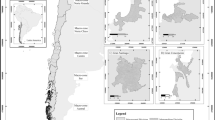Abstract
To improve natural disaster management, it is important to recognize the variability of the vulnerable populations exposed to hazards and to develop location-based emergency plans accordingly. This paper presents a mathematical model to establish a model of social vulnerability index (SoVI), which includes 12 social variables, and the regional social vulnerability to natural hazards was formulated by them. Taking a city as statistical unit, the variability of vulnerability to natural hazards was explored among the 323 cities based on the SoVI. The results indicate that vulnerability is a location-based regional phenomenon, with the most vulnerable cities being located in the southwest of China and the eastern areas being generally less vulnerable. The results will be helpful for policy makers to formulate disaster management plans, which can be beneficial for people in more vulnerable areas who are responding to, coping with, and recovering from natural disasters.



Similar content being viewed by others
References
Adger WN, Brooks N, Bentham G et al (2004) New indicators of vulnerability and adaptive capacity. In: Tyndall centre for climate change research technical report 7, University of East Anglia, Norwich
Blaikie P, Brookfield H (1987) Land degradation and society. Metheun & Company, Ltd., New York
Blaikie P, Cannon T, Davis I et al (1994) At risk: natural hazards, people’s vulnerability, and disasters. Routledge, New York
Borden KA, Schmidtlein MC, Emrich CT et al (2007) Vulnerability of U.S. Cities to Environmental Hazards. J Homel Secur Emerg Manag 4(2):(Online)1547–7355. doi:10.2202/1547-7355.1279
Chambers R (1989) Editorial introduction: vulnerability, coping and policy. IDS Bull 20:1–7. doi:10.1111/j.1759-5436.1989.mp20002001.x
Chang CY, Hsiao HC (2007) Establishing hazards-of-place model of vulnerability—a case of flood in the Shijhih City Taiwan. In: 2nd international conference on urban disaster reduction reduction, Taiwan
Cutter LS, Emrich CT (2006) Moral hazard, social catastrophe: the changing face of vulnerability along the hurricane coasts. Ann Am Acad 604:102–112
Cutter SL, Mitchell JT, Scott MS (1997) Handbook for conducting a GIS-based hazards assessment at the county level. South Carolina Emergency Preparedness Division, South Carolina
Cutter SL, Mitchell JT, Scott MS (2000) Revealing the vulnerability of people and places: a case study of georgetown county, South Carolina. Ann Assoc Am Geogr 90(4):713–737
Cutter SL, Boruff BJ, Shirley WL (2003) Social vulnerability to environmental hazards. Soc Sci Quart 84(2):242–261
Dahl AL (1991) Island directory. UNEP regional seas directories and bibliographies No.35, UNEP, Nairobi
Dwyer A, Zoppou C, Nielsen O et al (2004) Quantifying social vulnerability: a methodology for identifying those at risk to natural hazards. Geoscience Australia Record 2004/14
ECLAC (2003) A methodological framework for a social vulnerability index in the caribbean subregion. In: Document presented at the ad hoc expert group meeting on a methodological approach for a social vulnerability index for small Island developing states
Hewitt K (1997) Regions of risk: a geographical introduction to disaster. Longman, Essex
King D, MacGregor C (2000) Using social indicators to measure community vulnerability to natural hazards. Aust J Emerg Manag 15(3):52–57
Masozera M, Bailey M, Kerchner C (2007) Distribution of impacts of natural disasters across income groups: a case study of New Orleans. Ecol Econ 63:299–306. doi:10.1016/j.ecolecon.2006.06.013
McCarthy JJ, Canziani OF, Leary NA et al (2001) Climate change 2001: impacts, adaptation and vulnerability. Cambridge University Press, Cambridge
Mileti D (1999) Disasters by design: a reassessment of natural hazards in the United States. National Academies Press, Washington
Morrow BH (1999) Identifying and mapping community vulnerability. Disasters 23(1):1–18
National Disaster Mitigation Center (2010) The overview of natural disaster in China, vol 1. Disaster reduction in China, pp 8–9 (in China)
OCHA (2010) Chile: Earthquake situation report #9. United Nations office for the coordination of humanitarian affairs partnership for humanity Web. http://reliefweb.int/sites/reliefweb.int/files/resources/3C1035B690C8ED8B492576F5008162A7-Full_Report.pdf
Renois C (2010) Haiti death toll tops 200 000 as aid anger mounts. Relief Web. http://reliefweb.int/report/haiti/haiti-death-toll-tops-200%C2%A0000-aid-anger-mounts
Rygel L, O’Sullivan D, Yarnal B (2006) A method for constructing a social vulnerability index: an application to hurricane storm surges in a developed country. Mitig Adapt Strat Glob Change 11:741–764
Saaty TL (1990) How to make a decision: the analytic hierarchy process. Eur J Oper Res 48(1):9–26
Schmidtlein MC, Shafer JM, Berry M et al (2011) Modeled earthquake losses and social vulnerability in Charleston, South Carolina. Appl Geograp 31(1):269–281
Tapsell S, McCarthy S, Faulkner H et al (2010) Social vulnerability to natural hazards. CapHaz-Net consortium, Middlesex University, UK
Blaikie P (1985) The political economy of social erosion in developing countries. Longman, London
UN/ISDR (2004) Implementation of the International Strategy for Disaster Reduction, A/59/228 Geneva. The United Nations Office for Disaster Risk Reduction Web. http://www.unisdr.org/we/inform/resolutions-reports
Weichselgartner J (2001) Disaster mitigation: the concept of vulnerability revisited. Disaster Preven Manag 10(2):85–95. doi:10.1108/09653560110388609
Wisner B, Blaikie P, Cannon T et al (2005) At risk: natural hazard, people’s vulnerability and disasters, 2nd edn. Taylor & Francis e-Library Press, UK
Acknowledgments
This research was funded by Asian Studies Center of Nankai University.
Author information
Authors and Affiliations
Corresponding author
Rights and permissions
About this article
Cite this article
Lixin, Y., Xi, Z., Lingling, G. et al. Analysis of social vulnerability to hazards in China. Environ Earth Sci 71, 3109–3117 (2014). https://doi.org/10.1007/s12665-013-2689-0
Received:
Accepted:
Published:
Issue Date:
DOI: https://doi.org/10.1007/s12665-013-2689-0




